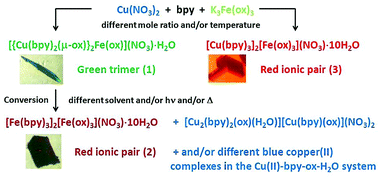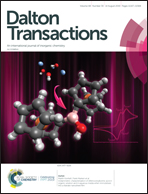Solvent-assisted structural conversion involving bimetallic complexes based on the tris(oxalato)ferrate(iii) unit with the green → blue → red crystal color sequence†
Abstract
Three new complexes forming a dynamic system and given by the following formulae: [Cu2(bpy)4Fe(ox)3]NO3·H2O 1, [Fe(bpy)3]2[Fe(ox)3]NO3·10H2O 2 and [Cu(bpy)3]2[Fe(ox)3]NO3·10H2O 3 (bpy – 2,2′-bipyridine, ox – oxalate), were synthesized from a methanol–water mixture or water, and characterized structurally, spectroscopically and magnetically. Compound 1 contains trinuclear [(bpy)2Cu(μ-ox)Fe(ox)(μ-ox)Cu(bpy)2]+ cations, while 2 and 3 can be classified as isomorphous ionic compounds, with alternately arranged hydrophobic and hydrophilic layers of mononuclear complex ions. The green crystals of 1 are perfectly stable in air, whereas in selected solvents they undergo irreversible solvent-assisted recrystallization towards red crystals of 2, which is also accompanied by the appearance of mononuclear blue copper complexes with oxalate, 2,2′-bipyridine and aqua ligands, already described in the literature. The above crystallization/recrystallization processes indicate variable solution contents. The whole effect is accelerated by both the increased temperature and day light irradiation, however, different products from the pool prevail under various conditions. The observed transformation can be understood in terms of thermodynamic and kinetic control, involving the known photo-activity of [Fe(ox)3]3− moieties and the effect of quadruple aryl embrace (QAE) on the stability of the crystal network. Considering the presence of FeIII–ox–CuII connectivity in 1 we performed detailed magnetic studies and theoretical calculations for this compound. Due to the strong asymmetry of Cu–O bonds the antiferromagnetic coupling is rather weak, with JCu–Fe being ca. −3.4 cm−1 (using Hamiltonian of the type H = −JCu–Fe(SCu1SFe + SFeSCu2) − JCu–Cu(SCu1SCu2)). We found that these values are very close to those predicted by B3LYP/6-311G* calculations.



 Please wait while we load your content...
Please wait while we load your content...